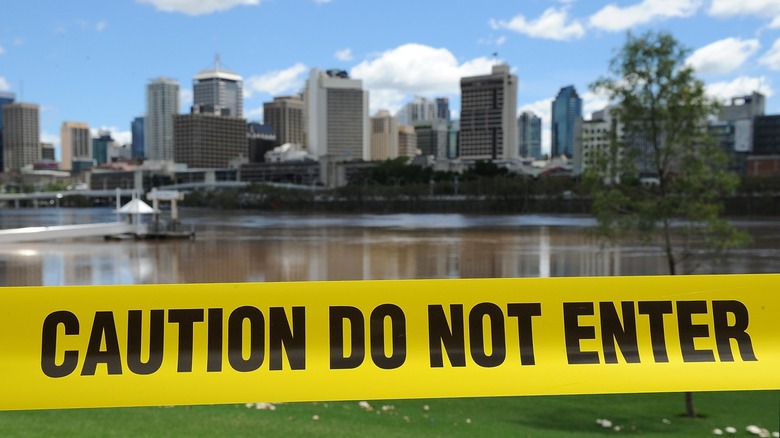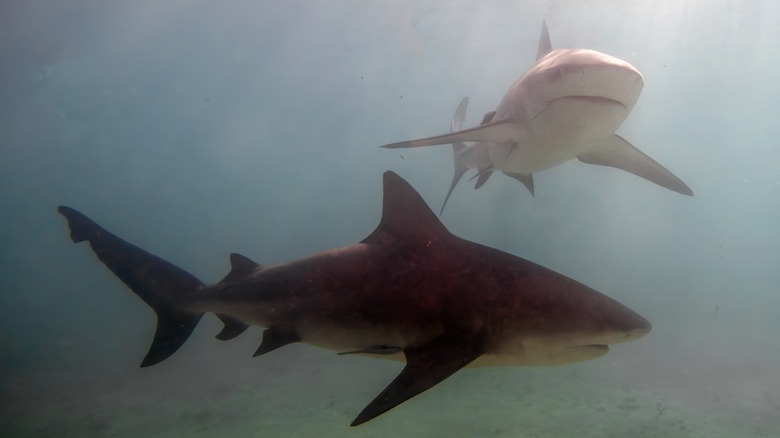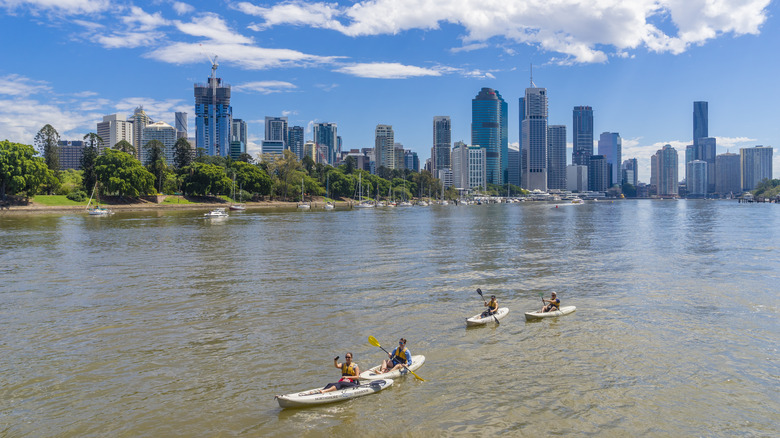This Popular River In Australia Is Dangerous To Swim In For Several Reasons
When people think of Australia, the word "dangerous" often comes to mind due to the country's reputation for a wide array of threatening wildlife and challenging environments. However, perceptions can shift when thinking of a sunny metropolitan city like Brisbane, the capital of Queensland. But Australia carries this reputation for a reason, and the Brisbane River offers no exception to the rule: it is a notoriously dangerous place to swim.
Before we dive into these dangers, it's important to know where the river's water comes from. This river is an estuary: a coastal body of water where freshwater from inland sources mixes with saltwater from the ocean. This mixing of waters in the estuary causes tides to bring in a large amount of sediment that contains heavy metals, such as mercury and copper, resulting in murky, unsettled water that appears unclean. This characteristic has earned the river the nickname "the Brown Snake," leading to the first danger point: water quality.
The Brisbane River's water quality has been a concern for decades. Industrial activities, urban runoff, and agricultural pollutants upstream have historically contributed to the river's contamination — and the situation is not improving. High nitrogen and phosphorus levels contribute to excessive algae, while enterococci bacteria lurk at dangerous levels. People with low immunity may experience diarrhea, conjunctivitis, and respiratory infections, among other diseases, after coming into contact with the water. You will see such a warning on general information signs posted by the Brisbane City Council.
Brisbane River: bull sharks, debris, and strong currents
Let's delve deeper and cut to the chase. There are 3,000 bull sharks in the Brisbane River — an extremely aggressive fish that can adapt to both saltwater and freshwater bodies. Thankfully, there have been no reported shark attacks, but plenty of sightings. Although bull shark sightings are more common near the river's mouth, keeping children and pets away from the water's edge is particularly important, as they are more vulnerable to falling in and potentially suffering a fatal shark bite.
Another significant risk factor is the presence of tons of debris in the river, especially following storms and floods, often during December and February. Swimmers can easily be injured by objects ranging from branches to rubbish and ever larger items, like literal cars, swept along by the current. The Brisbane River is also a busy waterway frequented by ferries, commercial ships, and private boats. The risk of collision with such heavy marine traffic is real for anyone in the water.
The river is also known for its strong currents and rapidly changing tides — water conditions can shift unexpectedly. Certain areas of the river experience particularly strong cross-stream direction currents, where water flows swiftly around natural bends or structures. It's important to note that warning signs are posted whenever there are elevated safety concerns, such as high bacteria levels or shark sightings, and adhering to these advisories is highly recommended — these regulations are designed to protect the public from all the hazards above.
Activities besides swimming
Brisbane offers safer alternatives to swimming in the river for those looking to enjoy the water so you can avoid bull sharks, enterococci germs, and floating cars! The city boasts several public pools and water parks, such as those in South Bank. This vibrant neighborhood offers free-of-charge, controlled swimming environments like the South Bank Parklands that are perfect for a fun day in the sun. It's also conveniently located near famous landmarks like the Brisbane sign and the Wheel of Brisbane, where you can catch stunning views of the Brisbane skyline.
However, if you insist on interacting with the Brisbane River, there are several ways to avoid its dangers. If you're confident enough, there is no better way to experience it than to kayak or paddleboard. You can rent them from Kangaroo Point or book an organized tour with Riverlife to experience a 90-minute day adventure. For something a little more hands-off, try riding the CityCats or the KittyCats, an inexpensive network of catamarans that run frequently along the Brisbane River. They'll take you on a scenic ride to multiple different destinations across the city.
However, before you decide to participate in anything on the Brisbane River, always stay vigilant and check alerts prior to your activity. Check out The Brisbane River Community Safety Forum on Facebook for the latest updates. And, if you see somebody swimming in the river, don't be a Spielberg and film the next Australian "Jaws" — get them out!


